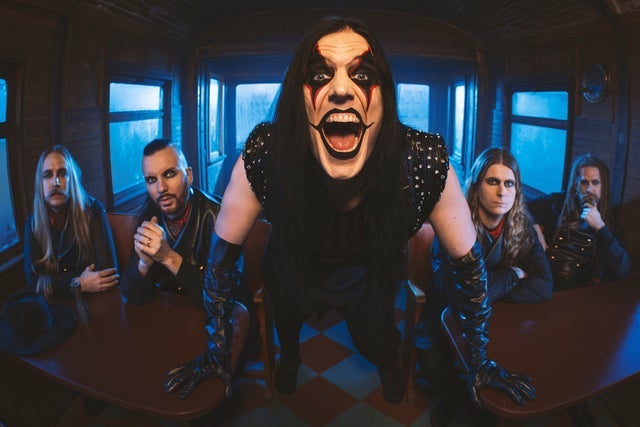Event research Avatar - In The Airwaves - USA 2025
Avatar - In The Airwaves - USA 2025 tickets are on sale right now.
Are Avatar - In The Airwaves - USA 2025 tickets likely to be profitable in Las Vegas, NV?
There are 9 presales for this event - we have 5 unique passwords for these presales.
Avatar - In The Airwaves - USA 2025
Brooklyn Bowl Las Vegas
Las Vegas, NV
Nov 8 Sat • 2025 • 6:30pm
Alternative Rock | Hard Rock/Metal | Festivals | Metal | Rock and Pop | Rap and Hip-Hop | Dance/ElectronicAi Ticket Reselling Prediction
Sign Up to get artificial intelligence powered ticket reselling predictions!
Using artificial intelligence, concert attendance stats, and completed sales history for ticket prices on secondary market sites like Stubhub, we can predict whether this event is hot for resale. The Ai also considers factors like what music genre, and what market the concert is in.
Shazam is a music app that helps you identify the music playing around you. The more times an artist gets Shazamed, the higher this score will be, which should give you an idea of the popularity of this artist. Scores are ranked on a scale of 1 to 5. Learn more
Google Trends shows how popular a search query is for an artist. The more popular the artist is and the more people that are Googling them, the higher this score will be. Scores are ranked on a scale of 1 to 5. Learn more
3,000
Capacity
Avatar - In The Airwaves - USA 2025 at the Brooklyn Bowl Las Vegas, Las Vegas, NV
Presale Passwords & On Sale Times
Avatar - In The Airwaves - USA 2025
Tour Schedule
Avatar - In The Airwaves - USA 2025
52 similar events found
Watch on YouTube
Listen on iTunes
Wikipedia Bio

Avatar (Sanskrit: अवतार, IAST: Avatāra; pronounced [ɐʋɐt̪aːɾɐ]) is a concept within Hinduism that "in Sanskrit" literally means 'descent'. It signifies the material appearance or incarnation of a powerful deity, or spirit on Earth, including in human form.[1][2] The relative verb to "alight, to make one's appearance" is sometimes used to refer to any guru or revered human being.[3][4]
The word avatar does not appear in the Vedic literature;[5] however, it appears in developed forms in post-Vedic literature, and as a noun particularly in the Puranic literature after the 6th century CE.[6] Despite that, the concept of an avatar is compatible with the content of the Vedic literature like the Upanishads as it is symbolic imagery of the Saguna Brahman concept in the philosophy of Hinduism. The Rigveda describes Indra as endowed with a mysterious power of assuming any form at will.[7][8] The Bhagavad Gita expounds the doctrine of Avatara but with terms other than avatar.[6][4]
Theologically, the term is most often associated with the Hindu god Vishnu, though the idea has been applied to other deities.[9] Varying lists of avatars of Vishnu appear in Hindu scriptures, including the ten Dashavatara of the Garuda Purana and the twenty-two avatars in the Bhagavata Purana, though the latter adds that the incarnations of Vishnu are innumerable.[10] The avatars of Vishnu are important in the theology of Vaishnavism. In the goddess-based Shaktism tradition of Hinduism, avatars of the Devi in different appearances such as Tripura Sundari, Durga, Chandi, Chamunda, Mahakali, and Kali are commonly found.[11][12][13] While avatars of other deities such as Ganesha and Shiva are also mentioned in medieval Hindu texts, this is minor and occasional.[14] The avatar doctrine is an important distinction in Vaishnavism and one that is absent from Shaivism, another major Hindu movement.[15][16]
Incarnation concepts that are in some aspects similar to avatar are also found in Buddhism,[17] Christianity,[5] and other religions.[17]
The scriptures of Sikhism include the names of numerous Hindu gods and goddesses, but it rejected the doctrine of savior incarnation and endorsed the view of Hindu Bhakti movement saints such as Namdev, that formless eternal god is within the human heart, and man is his own savior.[18][19]
- ^ Cite error: The named reference
jameslochtefeldavatarwas invoked but never defined (see the help page). - ^ Geoffrey Parrinder (1997). Avatar and Incarnation: The Divine in Human Form in the World's Religions. Oneworld. pp. 19–20. ISBN 978-1-85168-130-3.
- ^ Cite error: The named reference
monierwilliamsavatarwas invoked but never defined (see the help page). - ^ a b Sheth 2002, pp. 98–99.
- ^ a b Daniel E Bassuk (1987). Incarnation in Hinduism and Christianity: The Myth of the God-Man. Palgrave Macmillan. pp. 2–4. ISBN 978-1-349-08642-9.
- ^ a b Hacker 1978, pp. 424, also 405–409, 414–417.
- ^ Rig Veda 3.53.8 (Maghavan); 6.47.18 (Indra)
- ^ Swami Harshananda, A Concise Encyclopaedia of Hinduism, Ramakrishna Math, Bangalore (2008) Vol.1, page 221
- ^ Kinsley, David (2005). Lindsay Jones (ed.). Gale's Encyclopedia of Religion. Vol. 2 (Second ed.). Thomson Gale. pp. 707–708. ISBN 978-0-02-865735-6.
- ^ Bryant, Edwin Francis (2007). Krishna: A Sourcebook. Oxford University Press US. p. 18. ISBN 978-0-19-514891-6.
- ^ Sheth 2002, pp. 98–125.
- ^ Hawley, John Stratton; Vasudha Narayanan (2006). The life of Hinduism. University of California Press. p. 174. ISBN 978-0-520-24914-1.
- ^ David R. Kinsley (1998). Tantric Visions of the Divine Feminine: The Ten Mahāvidyās. Motilal Banarsidass. pp. 115–119. ISBN 978-81-208-1522-3.
- ^ James Lochtefeld (2002), "Shiva" in The Illustrated Encyclopedia of Hinduism, Vol. 2: N-Z, Rosen Publishing, ISBN 0-8239-2287-1, page 635
- ^ Cite error: The named reference
laiengavatarwas invoked but never defined (see the help page). - ^ Cite error: The named reference
ryanjonesavatarwas invoked but never defined (see the help page). - ^ a b Sheth 2002, pp. 115–116 with note 2.
- ^ Cite error: The named reference
enesbittavatarwas invoked but never defined (see the help page). - ^ Christopher Shackle and Arvind Mandair (2005), Teachings of the Sikh Gurus, Routledge, ISBN 978-0415266048, pp. xxxiv–xli
Source: Wikipedia



